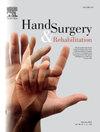前臂慢性劳力性筋膜室综合征:超声引导手术技术。
IF 1
4区 医学
Q4 ORTHOPEDICS
引用次数: 0
摘要
前臂慢性运动室综合征最常与运动有关。它表现为活动几分钟后痉挛,需要停止运动。我们描述了一种超声引导下的手术技术治疗前臂慢性运动室综合征。解剖和病理生理:前臂由三个腔室组成:前腔室、侧腔室和背腔室。这些隔室由前臂肌肉形成,并被由结缔组织组成的纤维弹性膜包围。前臂的重复性活动导致不可伸展隔室内肌肉体积的增加。压力的增加导致疼痛和痉挛,迫使个体停止活动。诊断是基于测量肌间室压力。手术技术:手术治疗包括进行筋膜切开术。这可以通过沿前臂长度的切口或通过内镜或超声引导的微创入路来完成。超声波引导技术使用两个小入口和一把专用刀。术后无需固定,可使患者迅速恢复活动。讨论:前臂慢性运动室综合征是摩托车手中特别常见的一种疾病。诊断是基于暗示性临床表现和病理性肌内压的结合。治疗可采用保守或手术(筋膜切开术)。筋膜切开术可采用开放入路或微创超声引导技术。发表的关于超声引导治疗的研究报告了手术后快速恢复运动活动的良好效果。本文章由计算机程序翻译,如有差异,请以英文原文为准。
Chronic exertional compartment syndrome in the forearm: Ultrasound-guided surgical technique
Introduction
Chronic exertional compartment syndrome of the forearm is most commonly associated with exercise. It presents as cramping after a few minutes of activity, requiring cessation of exercise. We describe an ultrasound-guided surgical technique for the treatment of forearm chronic exertional compartment syndrome.
Anatomy and Pathophysiology
The forearm consists of three compartments: the anterior, lateral, and dorsal compartments. These compartments are formed by the muscles of the forearm and are surrounded by a fibroelastic membrane composed of connective tissue. Repetitive activity in the forearm leads to an increase in muscle volume within a non-extensible compartment. This increase in pressure causes pain and cramping, forcing the individual to stop the activity. Diagnosis is based on measurement of intramuscular compartment pressures.
Surgical Technique
Surgical treatment involves performing a fasciotomy. This can be done through an incision along the length of the forearm or through a minimally invasive approach using endoscopic or ultrasound guidance. The ultrasound-guided technique uses two small entry points and a specialized knife. No post-operative immobilization is required, allowing patients to quickly resume their activities.
Discussion
Chronic exertional compartment syndrome of the forearm is a condition that is particularly common among motorcyclists. Diagnosis is based on a combination of a suggestive clinical presentation and pathological intramuscular pressure. Treatment may be conservative or surgical (fasciotomy). Fasciotomy can be performed using an open approach or a minimally invasive ultrasound-guided technique. Published studies on ultrasound-guided treatment report excellent results with a rapid return to sports activities after surgery.
求助全文
通过发布文献求助,成功后即可免费获取论文全文。
去求助
来源期刊

Hand Surgery & Rehabilitation
Medicine-Surgery
CiteScore
1.70
自引率
27.30%
发文量
0
审稿时长
49 days
期刊介绍:
As the official publication of the French, Belgian and Swiss Societies for Surgery of the Hand, as well as of the French Society of Rehabilitation of the Hand & Upper Limb, ''Hand Surgery and Rehabilitation'' - formerly named "Chirurgie de la Main" - publishes original articles, literature reviews, technical notes, and clinical cases. It is indexed in the main international databases (including Medline). Initially a platform for French-speaking hand surgeons, the journal will now publish its articles in English to disseminate its author''s scientific findings more widely. The journal also includes a biannual supplement in French, the monograph of the French Society for Surgery of the Hand, where comprehensive reviews in the fields of hand, peripheral nerve and upper limb surgery are presented.
Organe officiel de la Société française de chirurgie de la main, de la Société française de Rééducation de la main (SFRM-GEMMSOR), de la Société suisse de chirurgie de la main et du Belgian Hand Group, indexée dans les grandes bases de données internationales (Medline, Embase, Pascal, Scopus), Hand Surgery and Rehabilitation - anciennement titrée Chirurgie de la main - publie des articles originaux, des revues de la littérature, des notes techniques, des cas clinique. Initialement plateforme d''expression francophone de la spécialité, la revue s''oriente désormais vers l''anglais pour devenir une référence scientifique et de formation de la spécialité en France et en Europe. Avec 6 publications en anglais par an, la revue comprend également un supplément biannuel, la monographie du GEM, où sont présentées en français, des mises au point complètes dans les domaines de la chirurgie de la main, des nerfs périphériques et du membre supérieur.
 求助内容:
求助内容: 应助结果提醒方式:
应助结果提醒方式:


